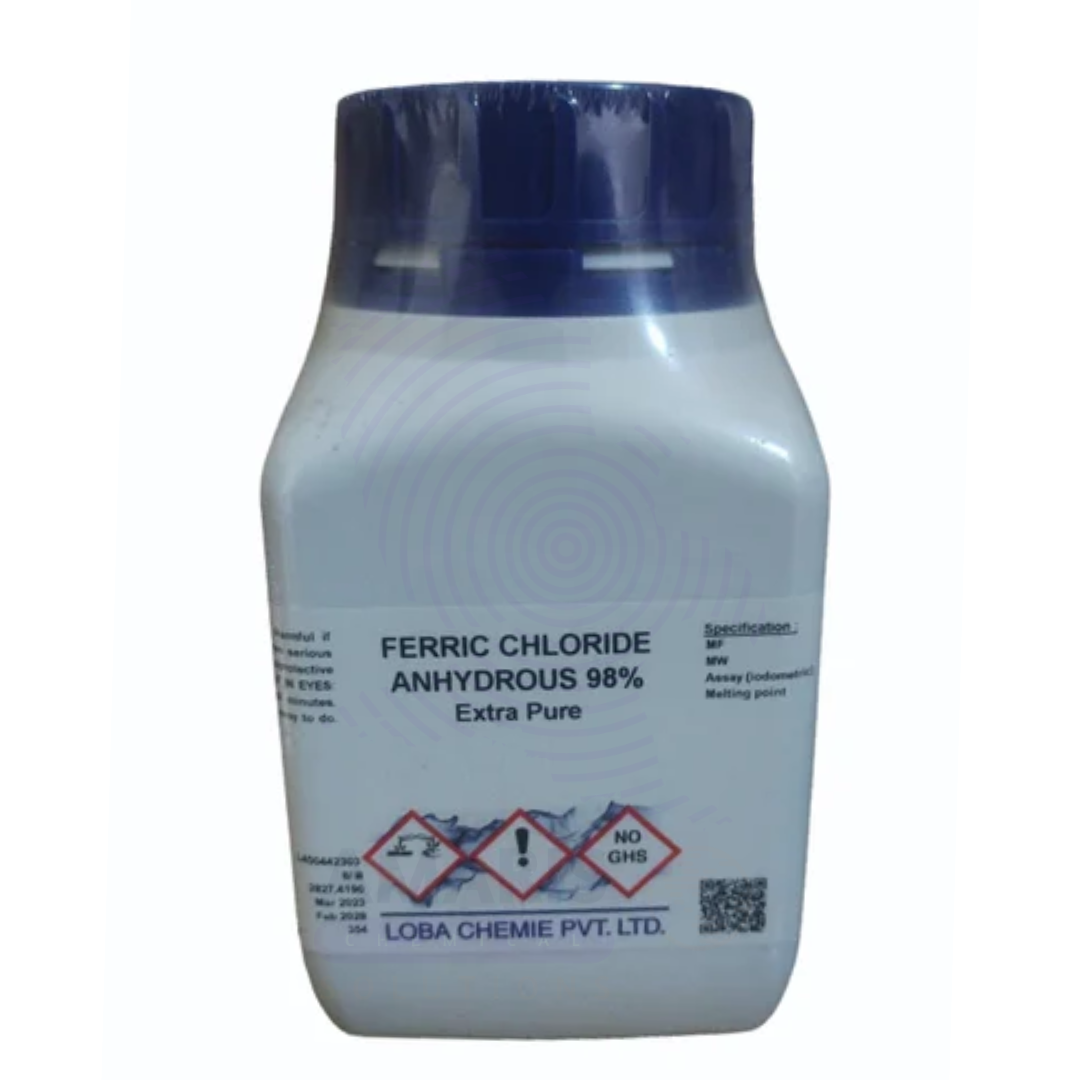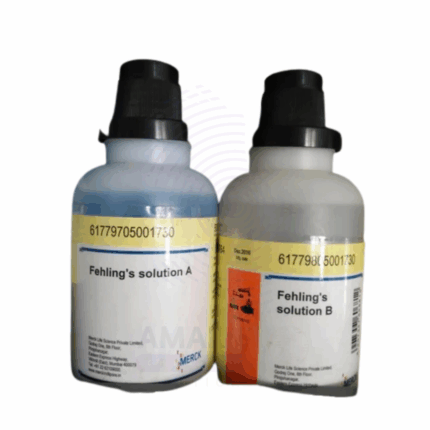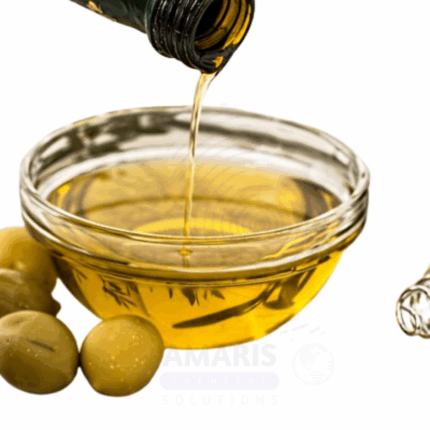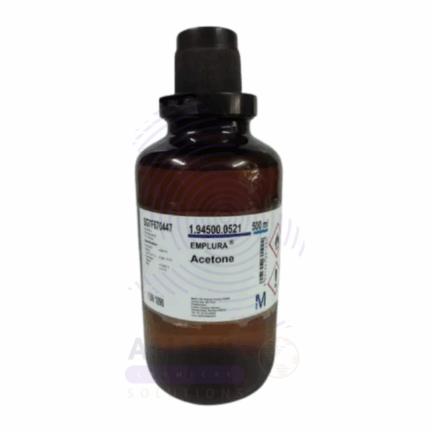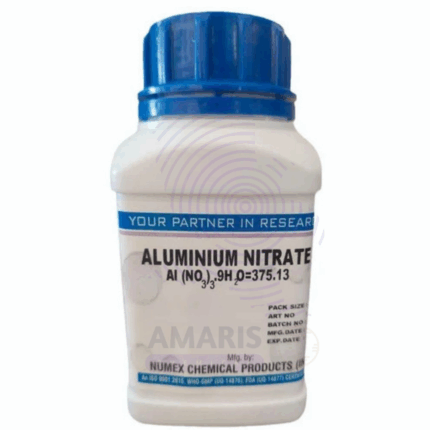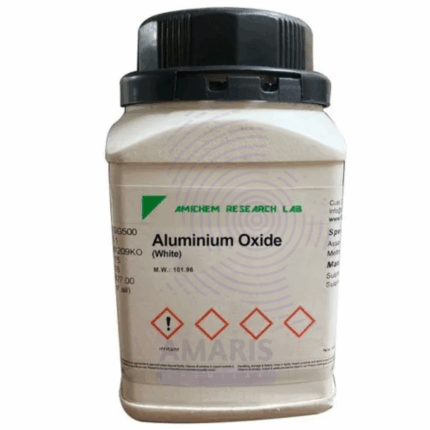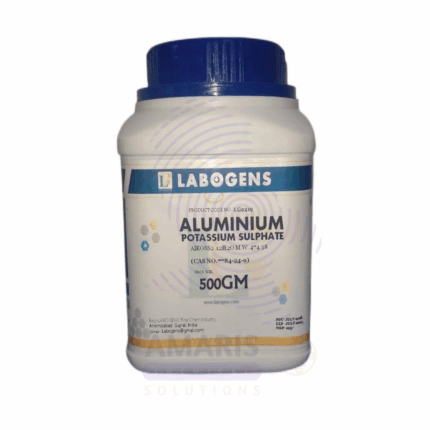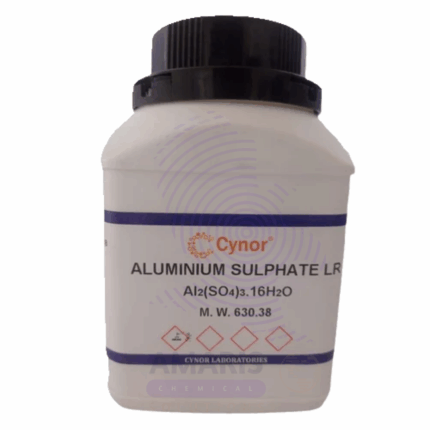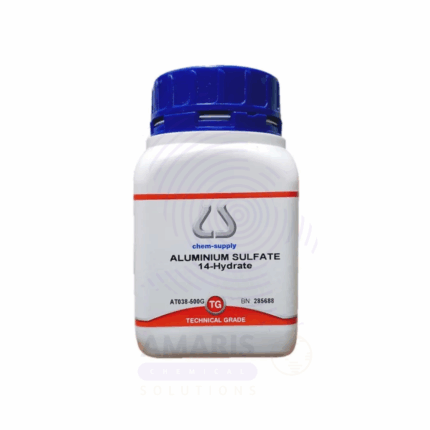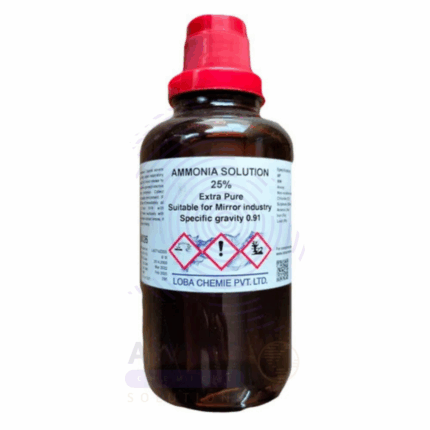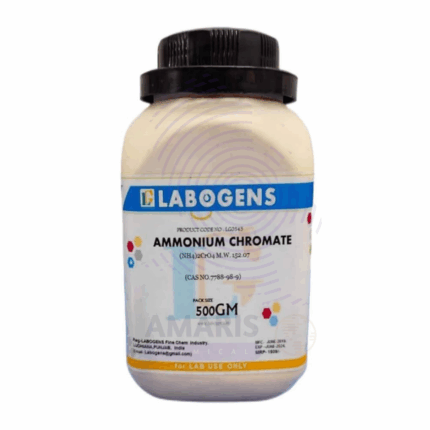“Aluminium Oxide Active Neutral Extra Pure” has been added to your cart. View cart
Ferric Chloride Anhydrous Extra Pure
$ 17.20
Whatsapp Order
Ferric Chloride Anhydrous Extra Pure is a highly refined, moisture-free compound composed of iron and chlorine (FeCl₃). In laboratory settings, it is widely used as a reagent for detecting phenols and as an etching agent for metals, especially in printed circuit board (PCB) production. Its strong oxidizing properties also make it suitable for redox reactions, qualitative analysis, and inorganic synthesis. This extra pure grade ensures minimal impurities, making it ideal for precise and controlled chemical experiments.
Description
Table of Contents
Toggle
Ferric Chloride Anhydrous Extra Pure
Primary Uses
- Etching agent for metals (especially copper):
Widely used in PCB (printed circuit board) fabrication and metallography to etch copper and other metals. - Precipitating agent in chemical analysis:
Reacts with various anions (e.g., phosphate, carbonate) to form characteristic precipitates, aiding in qualitative analysis. - Test for phenols (Ferric Chloride test):
Produces a violet, green, or blue color when reacted with phenol compounds, useful in organic compound identification. - Catalyst in organic synthesis:
Acts as a Lewis acid catalyst in reactions such as chlorination of aromatic compounds and Friedel–Crafts reactions.
Secondary Uses
- Coagulant in water treatment simulations:
Demonstrates coagulation and flocculation processes in environmental science labs. - Oxidizing agent in redox experiments:
Instructive in redox titrations or demonstrations involving electron transfer. - Preparation of iron complexes in coordination chemistry:
Used in synthesis of iron-based coordination compounds for educational or research purposes. - Pigment formation studies:
Useful in reactions forming iron-based pigments (e.g., Prussian blue).
Additional information
| PACK SIZE |
500 grams Plastic Tin |
|---|
KEY PRODUCT FEATURES
1. Basic Identification Attributes
- Chemical Name: Ferric Chloride Anhydrous
- Synonyms: Iron(III) chloride, Iron trichloride
- Chemical Formula: FeCl₃
- Molecular Weight: 162.2 g/mol
- Grade: Extra Pure (Laboratory Reagent Grade)
- Appearance: Dark brown to black crystalline solid with pungent odor
2. Physical & Chemical Properties
- Melting Point: ~306 °C
- Boiling Point: ~316 °C (sublimes)
- Solubility: Reacts violently with water, forming hydrochloric acid and ferric hydroxide
- Hygroscopic: Yes
- Odor: Sharp, acrid
3. Safety & Hazard Attributes
- GHS Classification:
- Corrosive to skin and eyes (Category 1)
- Acute toxicity (Oral, Category 4)
- Environmental hazard (Aquatic Chronic, Category 2)
- Hazard Statements:
- H302: Harmful if swallowed
- H314: Causes severe skin burns and eye damage
- H411: Toxic to aquatic life with long lasting effects
- PPE Requirements:
- Chemical-resistant gloves (nitrile)
- Goggles or face shield
- Lab coat
- Use in fume hood or well-ventilated area
- First Aid Measures:
- Inhalation: Move to fresh air; seek medical help
- Skin Contact: Rinse with water for 15 minutes
- Eye Contact: Flush with water immediately, get medical attention
- Ingestion: Do not induce vomiting; rinse mouth and seek medical attention
4. Storage & Handling Attributes
- Storage Conditions:
- Store in tightly sealed, non-metallic container
- Keep in cool, dry area away from moisture
- Avoid contact with metals and reducing agents
- Handling Notes:
- Handle in dry atmosphere (moisture-sensitive)
- Do not allow contact with skin or eyes
- Avoid generating dust
5. Regulatory & Compliance Attributes
- CAS Number: 7705-08-0
- EC Number: 231-729-4
- UN Number: UN 1773
- Hazard Class: 8 (Corrosive substances)
- Packaging Group: III
6. Laboratory Applications
- Primary Uses:
- Etching agent for metals (especially copper in PCB manufacturing)
- Precipitating agent in water and wastewater treatment
- Catalyst in organic synthesis
- Chlorination and oxidation reactions
- Secondary Uses:
- Laboratory testing of phenols and other aromatic compounds
- Preparation of ferric salts
- Educational demonstrations of hygroscopic and exothermic reactions
SAFETY HANDLING PRECAUTIONS
SAFETY PRECAUTIONS
- Corrosive – can cause severe skin and eye burns
- Releases HCl fumes upon contact with moisture
- Use gloves, eye protection, and lab coat
- Work in a well-ventilated area or fume hood
Storage:
- Store in tightly sealed containers in a cool, dry place
- Protect from moisture and humidity
FIRST AID MEASURES
- Inhalation: Move to fresh air, seek medical help if breathing is difficult
- Skin/Eye Contact: Flush immediately with water for at least 15 minutes; remove contaminated clothing
- Ingestion: Rinse mouth, do not induce vomiting—seek immediate medical attention
Related products
Acetone Extra Pure
Acetone Extra Pure is a highly volatile, flammable, and colorless liquid widely used as a powerful solvent in laboratory and industrial applications. Known for its exceptional ability to dissolve a wide range of substances, it is commonly employed for cleaning laboratory glassware, thinning resins, and removing organic residues. In the cosmetics and pharmaceutical industries, acetone is used in nail polish removers and formulation processes. Its high evaporation rate and purity make it suitable for analytical procedures and synthesis work, especially where contaminant-free solvents are essential. With a distinct odor and low boiling point, Acetone Extra Pure is an indispensable reagent for both routine and specialized chemical operations.
Aluminium Nitrate Extra Pure
Aluminium Nitrate Extra Pure is a high-purity, white crystalline compound that is highly soluble in water and widely used in laboratory chemistry for analytical, synthesis, and research purposes. It serves as a reliable source of aluminum ions in solution, making it valuable in qualitative analysis, coordination chemistry, and materials science studies. This compound is often utilized in the preparation of other aluminum salts, as a nitrating agent, and in controlled oxidation reactions. Its extra pure grade guarantees minimal interference from contaminants, ensuring accurate, reproducible results in sensitive experimental work. Aluminium Nitrate should be stored in tightly sealed containers, away from moisture and incompatible substances, due to its oxidizing nature and hygroscopicity.
Aluminium Oxide Extra Pure
Aluminium Oxide Extra Pure is a high-purity, white, odorless crystalline powder widely used in laboratory applications for its chemical stability, hardness, and high melting point. It serves as a reliable reagent in inorganic synthesis, a polishing and grinding medium in sample preparation, and a support material for catalysts in chemical reactions. This form of alumina is also used in adsorption studies, ceramic research, and as a desiccant in controlled drying processes. Its extra pure grade ensures minimal contamination, making it suitable for sensitive analytical work and high-precision experiments. For optimal performance, it should be stored in a dry, tightly sealed container to prevent moisture absorption and maintain its physical integrity.
Aluminium Potassium Sulphate Hydrated Extra Pure
Aluminium Potassium Sulphate Hydrated Extra Pure, commonly known as potash alum, is a high-purity, colorless to white crystalline compound containing water of crystallization. It is widely used in laboratory settings for analytical chemistry, especially in the preparation of standard solutions, precipitation reactions, and as a source of aluminum ions. Its astringent and antiseptic properties also make it useful in biochemical and pharmaceutical experiments. The hydrated form offers improved handling and solubility in water, which supports its use in buffer systems and crystal growth studies. With minimal impurities, the extra pure grade ensures consistent and reliable results in sensitive research applications. It should be stored in a dry, cool environment in well-sealed containers to preserve its quality and prevent moisture loss.
Aluminium Sulphate Anhydrous Extra Pure
Aluminium Sulphate Anhydrous Extra Pure is a high-purity, white crystalline or powdery solid commonly used in laboratory chemistry as a source of aluminum ions for precipitation, titration, and coordination studies. Its anhydrous form provides a concentrated and stable option for applications requiring precise control over water content, such as analytical reagent preparation, pH adjustment, and synthesis of other aluminum salts. This compound is also used in paper sizing experiments, dye fixation, and water treatment research. The extra pure grade ensures very low levels of contaminants, supporting accurate and reproducible results in sensitive experimental work. It should be stored in airtight containers in a dry area to prevent moisture absorption and preserve its chemical integrity.
Aluminium Sulphate Hydrous Extra Pure
Aluminium Sulphate Hydrous Extra Pure is a high-purity, white to slightly off-white crystalline compound containing bound water molecules, commonly used in laboratory settings for analytical, inorganic, and coordination chemistry. It serves as a reliable source of aluminum ions in aqueous solutions and is frequently employed in precipitation reactions, dye fixation studies, and flocculation experiments. The hydrous form offers improved solubility and ease of handling, making it suitable for educational labs and controlled research environments. Its extra pure grade ensures minimal interference from impurities, enabling accurate, reproducible results in sensitive analytical procedures. To maintain its stability and prevent further hydration or contamination, it should be stored in well-sealed containers in a cool, dry place.
Ammonia Solution Extra Pure
Ammonia Solution Extra Pure is a high-purity, clear, colorless liquid composed of ammonia gas dissolved in water, emitting a strong, characteristic pungent odor. Widely used in laboratory chemistry, it serves as a crucial reagent in acid-base titrations, complexometric analysis, and the preparation of ammonium salts and metal-ammonia complexes. Its alkaline nature makes it valuable for pH adjustment, cleaning of laboratory glassware, and as a reducing agent in certain analytical procedures. The extra pure grade ensures low levels of impurities, supporting reliable results in sensitive experimental work. Due to its volatility and corrosiveness, it should be handled in well-ventilated areas and stored in tightly sealed, chemically resistant containers.
Ammonium Chromate Extra Pure
Ammonium Chromate Extra Pure is a high-purity, yellow crystalline compound primarily used in laboratory settings for analytical and inorganic chemistry applications. It serves as a strong oxidizing agent and is commonly utilized in qualitative analysis, particularly in the detection of cations, and in the preparation of chromate-based reagents. Its high solubility in water and ability to act as a corrosion inhibitor also make it useful in material science and electrochemical experiments. Due to the presence of hexavalent chromium, it is toxic and environmentally hazardous, requiring strict handling procedures and protective equipment. The extra pure grade ensures minimal impurities, making it suitable for high-precision research. It must be stored in tightly sealed containers, away from light, heat, and incompatible substances.


 Preservatives(food)
Preservatives(food) Flavor Enhancers
Flavor Enhancers Acidulants
Acidulants Sweeteners
Sweeteners Antioxidants
Antioxidants Colorants(food)
Colorants(food) Nutraceutical Ingredients (food)
Nutraceutical Ingredients (food) Nutrient Supplements
Nutrient Supplements Emulsifiers
Emulsifiers
 Collectors
Collectors Dust Suppressants
Dust Suppressants Explosives and Blasting Agents
Explosives and Blasting Agents Flocculants and Coagulants
Flocculants and Coagulants Frothers
Frothers Leaching Agents
Leaching Agents pH Modifiers
pH Modifiers Precious Metal Extraction Agents
Precious Metal Extraction Agents
 Antioxidants(plastic)
Antioxidants(plastic) Colorants (Pigments, Dyes)
Colorants (Pigments, Dyes) Fillers and Reinforcements
Fillers and Reinforcements Flame Retardants
Flame Retardants Monomers
Monomers Plasticizers
Plasticizers Polymerization Initiators
Polymerization Initiators Stabilizers (UV, Heat)
Stabilizers (UV, Heat)
 Antifoaming Agents
Antifoaming Agents Chelating Agents
Chelating Agents Coagulants and Flocculants
Coagulants and Flocculants Corrosion Inhibitors
Corrosion Inhibitors Disinfectants and Biocides
Disinfectants and Biocides Oxidizing Agents
Oxidizing Agents pH Adjusters
pH Adjusters Scale Inhibitors( water)
Scale Inhibitors( water)
 Antioxidants(cosmetic)
Antioxidants(cosmetic) Emollients
Emollients Fragrances and Essential Oils
Fragrances and Essential Oils Humectants
Humectants Preservatives
Preservatives Surfactants(cosmetic)
Surfactants(cosmetic) Thickeners
Thickeners UV Filters
UV Filters
 Fertilizers
Fertilizers Soil Conditioners
Soil Conditioners Plant Growth Regulators
Plant Growth Regulators Animal Feed Additives
Animal Feed Additives Biostimulants
Biostimulants Pesticides (Herbicides, Insecticides, Fungicides)
Pesticides (Herbicides, Insecticides, Fungicides)
 Active Pharmaceutical Ingredients (APIs)
Active Pharmaceutical Ingredients (APIs) Excipients
Excipients Solvents(pharmaceutical)
Solvents(pharmaceutical) Antibiotics
Antibiotics Antiseptics and Disinfectants
Antiseptics and Disinfectants Vaccine Adjuvants
Vaccine Adjuvants Nutraceutical Ingredients (pharmaceutical)
Nutraceutical Ingredients (pharmaceutical) Analgesics & Antipyretics
Analgesics & Antipyretics
 Analytical Reagents
Analytical Reagents Solvents(lab)
Solvents(lab) Chromatography Chemicals
Chromatography Chemicals Spectroscopy Reagents
Spectroscopy Reagents microbiology-and-cell-culture-reagents
microbiology-and-cell-culture-reagents Molecular Biology Reagents
Molecular Biology Reagents Biochemical Reagents
Biochemical Reagents Inorganic and Organic Standards
Inorganic and Organic Standards Laboratory Safety Chemicals
Laboratory Safety Chemicals Specialty Laboratory Chemicals(Special Laboratory Equipment)
Specialty Laboratory Chemicals(Special Laboratory Equipment)
 Demulsifiers
Demulsifiers Hydraulic Fracturing Fluids
Hydraulic Fracturing Fluids Scale Inhibitors(oil)
Scale Inhibitors(oil) Surfactants(oil)
Surfactants(oil) Drilling Fluids
Drilling Fluids
 Dyes and Pigments
Dyes and Pigments Bleaching Agents
Bleaching Agents Softening Agents
Softening Agents Finishing Agents
Finishing Agents Antistatic Agents
Antistatic Agents
 Admixtures
Admixtures Waterproofing Agents
Waterproofing Agents Sealants and Adhesives
Sealants and Adhesives Curing Compounds
Curing Compounds Concrete Repair Chemicals
Concrete Repair Chemicals Anti-Corrosion Coatings
Anti-Corrosion Coatings
 Surfactants(cleaning)
Surfactants(cleaning) Builders
Builders Enzymes
Enzymes Solvents (Cleaning)
Solvents (Cleaning) Fragrances
Fragrances
 Electronic Chemicals
Electronic Chemicals Catalysts
Catalysts Lubricants
Lubricants Photographic Chemicals
Photographic Chemicals Refrigerants
Refrigerants Automotive chemicals
Automotive chemicals Pyrotechnic Chemicals
Pyrotechnic Chemicals
 Biodegradable Surfactants
Biodegradable Surfactants Bio-based Solvents
Bio-based Solvents Renewable Polymers
Renewable Polymers Carbon Capture Chemicals
Carbon Capture Chemicals Wastewater Treatment Chemicals
Wastewater Treatment Chemicals
 Pigments
Pigments Solvents(paint)
Solvents(paint) Specialty Coatings
Specialty Coatings Binders/Resins
Binders/Resins Additives
Additives Driers
Driers Anti-Corrosion Agents
Anti-Corrosion Agents Functional Coatings
Functional Coatings Application-Specific Coatings
Application-Specific Coatings
 Fresh Herbs
Fresh Herbs Ground Spices
Ground Spices Whole Spices
Whole Spices Spice Blends
Spice Blends Dried Herbs
Dried Herbs
 Leavening Agents
Leavening Agents Dough Conditioners
Dough Conditioners Flour Treatments
Flour Treatments Fat Replacers
Fat Replacers Decoratives
Decoratives Preservatives(baking)
Preservatives(baking)
 Plasticizers & Softeners
Plasticizers & Softeners Reinforcing Agents
Reinforcing Agents Adhesion Promoters
Adhesion Promoters Vulcanizing Agents
Vulcanizing Agents Antidegradants
Antidegradants Blowing Agents
Blowing Agents Fillers & Extenders
Fillers & Extenders Accelerators & Retarders
Accelerators & Retarders